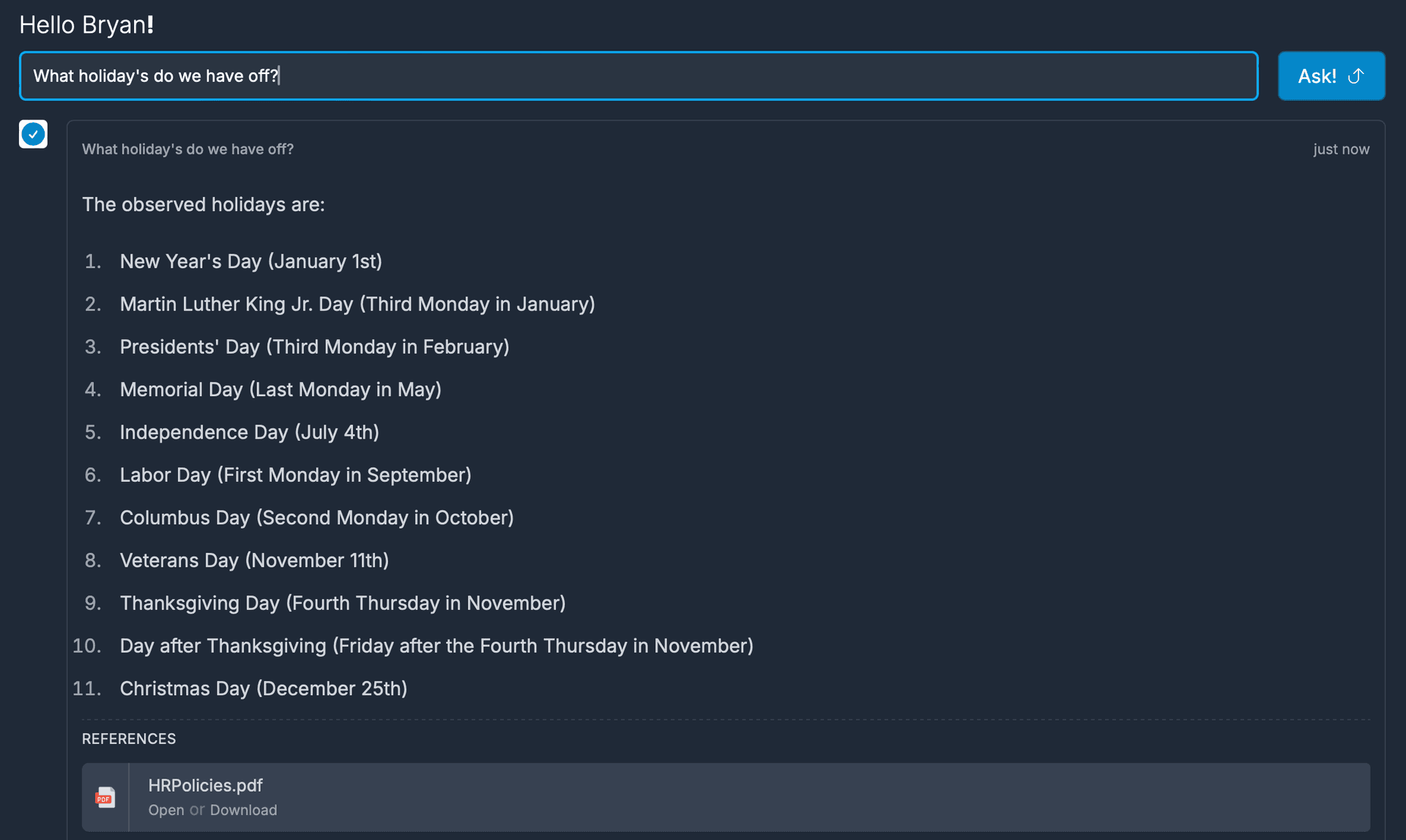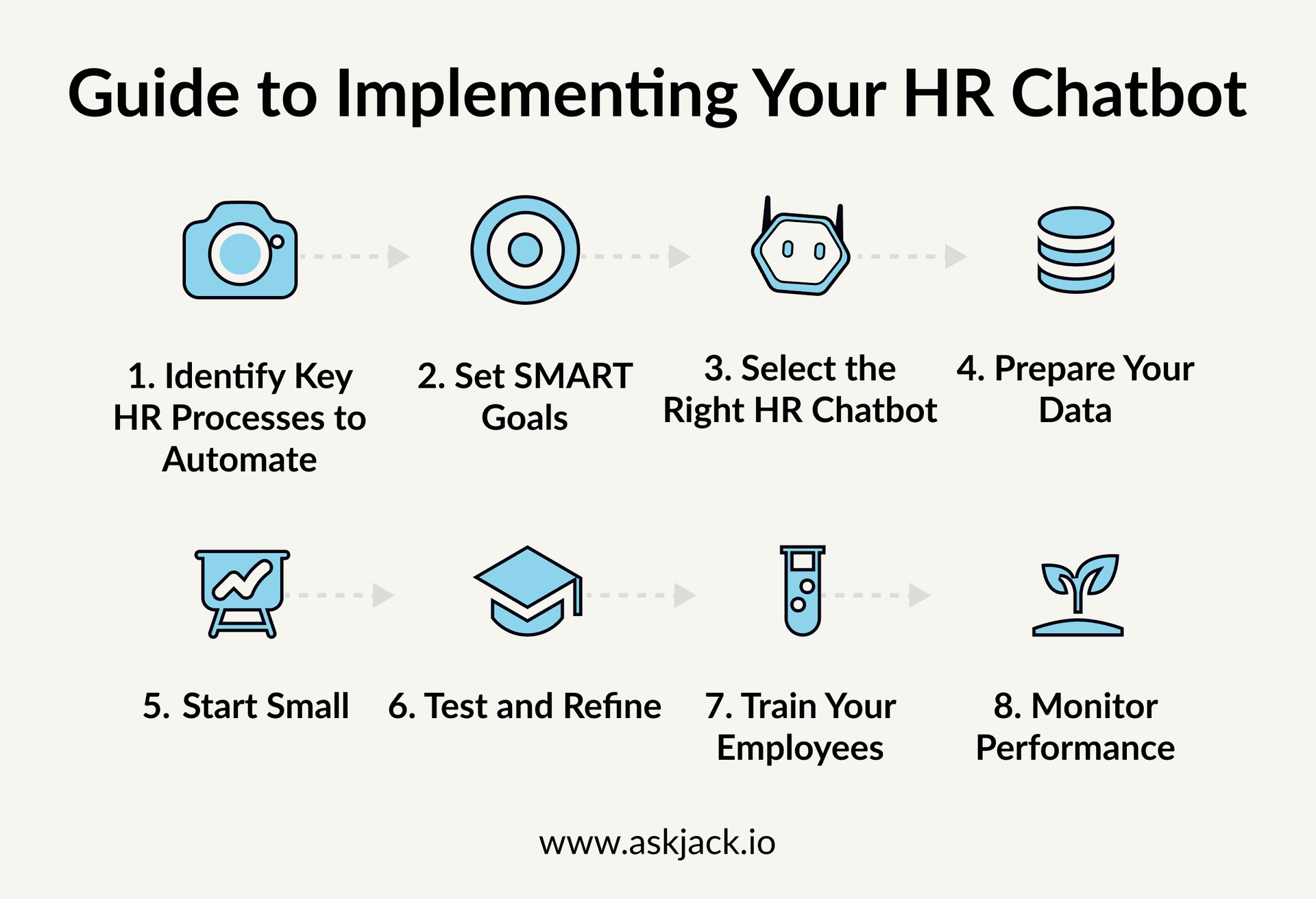Implementing an HR Chatbot for Enhanced Employee Engagement
CEO & Co-Founder
Table of Contents
Imagine an HR department that's constantly buzzing with activity, but struggles to keep up with employee inquiries. Screening applicants takes forever, and new hires wait days for answers to simple questions. This results in frustration for the HR team members as they struggle to manage all tasks. And it leaves employees frustrated waiting for answers.
What is an HR Chatbot?
An HR Chatbot is an AI-powered chatbot linked to your HR policies, procedures, and data. It uses your own companies data and apps to allow employees to be self-sufficient for come HR queries.
Think of them as HR virtual generalists that can scale the way HR departments operate. They can quickly allow employees to
- Be self sufficient with many common HR questions on policies and procedures
- Automate HR tasks such as requesting time off
- And free up HR professionals to focus on more strategic work.
Understanding HR Chatbots and Their "Magic"
HR chatbots are essentially chat programs designed specifically for HR purposes. They use artificial intelligence (AI) to understand employee questions and provide helpful responses.
Unlike basic chatbots, LLM's (Large Language Models) power HR chat bots. This allows them to understand the context of an employees question. Even when they phrase it in an usual way.
They also use technologies like RAG (Retrieval Augmented Generation) which stops AI-hallucinations. This is because they can only answer on the data you provide.
The Benefits of Integrating HR Chatbots
Integrating HR chatbots into your HR operations offers numerous benefits.

The benefits of an HR chatbot
HR chatbots offer new ways to perform traditional HR tasks and enhance employee interaction with HR. By automating routine tasks, chatbots in HR allow HR professionals to focus on more complex and strategic initiatives.
Improving HR Accessibility
HR chatbots increase HR accessibility by being available 24/7. This allows employees to get answers to their questions outside work hours. The chatbot sends questions it can't answer to the HR team. Allowing HR teams to focus on the tough questions.
HR Team Efficiency
HR chatbots significantly boost efficiency of your HR function. HR chat bots can handle basic tasks like answering common questions or managing one-off requests. This helps HR teams spend less time on paperwork and routine duties. For a deeper look at how AI can reduce support tickets and boost efficiency, check out our guide on 10 ways AI knowledge bases reduce employee support tickets .
This shift allows HR professionals to dedicate more time to strategic activities, such as talent development and employee engagement. It also allows them to do more with fewer HR generalists.
Increase Employee Engagement
HR chatbots for employee engagement can improve how employees feel connected to your company. Many employees feel frustrated because they feel disconnected and out of sync with the company.
A Human Resources chatbot can help workers learn what's new in other parts of the company. Effectively reducing company and team silos .
Improving Employee Onboarding
One of the most significant impacts of HR chatbots is on the employee onboarding process. HR chatbots improve employee onboarding by providing new hires with immediate answers. They also can guide new employees through initial setup.
This automation reduces the time required to spend on routine employee onboarding. Allowing the HR team to focus on the person and not the tasks.
Real-World Efficiency Examples
Several companies have successfully implemented HR chatbots and witnessed measurable improvements in their HR operations.
For example, a large companies use HR chatbots to handle common question on policies and procedures. To do this provide the AI-agent with the following data:
- Employee handbook
- Company culture deck
- All employee facing policies on vacation, days off, etc.
- Employee facing procedure on how to do work
This greatly reduces the volume of questions HR receives.
Other companies have automated parts of their onboarding process . This allows new hires to complete initial paperwork and training modules through a chatbot. This then allows them to learn at their own pace, but importantly lets them ask questions that the instructor may not have foreseen.
Key Features to Look for in an HR Chatbot
HR leaders should consider a few key features when picking an HR bot. These features ensure that the chatbot can effectively meet your company's needs and provide a positive employee experience.

An example of an HR chatbot, customize on your own company's data and providing a reference to where it found the employee's answer.
Essential features include using the latest AI LLM's (large language models), integration with company apps, customization, and security.
Here are some must-have features:
HR Chatbot Customization
A great HR chatbot experience starts with aligning it to your company culture. Things like how it answers and what it can answer on. Imagine a chatbot named Jill who welcomes new hires to your company and guides them through the onboarding process. Explaining your unique policies and culture.
Seamless Integration
The ideal chatbot integrates smoothly with your existing systems. Especially your document repositions and company knowledge bases. This ensures all the information the chatbot provides is accurate and up-to-date.
Accessibility
Ideally, the HR Chatbot should be accessible in its own web app which has a great user experience. It should also work where your company chats. Think Slack and Microsoft Teams.
Reporting
Finally, a good HR Chatbot can report back to the HR team what's on employees minds. Reporting that can share question themes and spot light documentation gaps is a plus.
Step-by-Step Guide to Implementing Your HR Chatbot
Implementing an HR chatbot requires careful planning and execution. But new ones can be setup quickly if you start off right.

A step-by-step guide to implementing your AI-powered HR chatbot system
Here is a step-by-step guide to help you successfully introduce an HR chatbot within your organization:
- Identify Key HR Processes to Automate: Start by identifying which HR processes will benefit most from automation. Common examples include answering frequently asked questions, processing leave requests, and assisting with onboarding.
- Set SMART Goals: Establish Specific, Measurable, Achievable, Relevant, and Time-bound goals for your HR chatbot implementation. For example, you might aim to reduce the volume of HR inquiries by 30% within six months.
- Select the Right HR Chatbot: Choose an HR chatbot that meets your organization's needs and has the necessary features, such as integration capabilities and customization options.
- Prepare Your Data: Ensure that the data the chatbot will access is accurate and up-to-date. This step is crucial for providing reliable information to employees. Use AI like ChatGPT to quickly update documents and fill in any gaps.
- Start Small: Begin by automating a few simple processes. Or providing access to readily available data, such as employee handbooks and HR policies.
- Test and Refine: Conduct a pilot test with a team to identify any issues and make necessary adjustments.
- Train Your Employees: Educate your employees on how to use the chatbot. Encourage them to provide feedback on their experience.
- Monitor Performance: Consistently track the chatbot's performance and make improvements based on user feedback and engagement metrics.
Common Challenges and Solutions in HR Chatbot Implementation
Introducing an HR chatbot can come with challenges, but these can be addressed with careful planning.
Common obstacles include data privacy concerns, integration issues, and employee resistance to new technology.
Solutions include implementing robust security measures, ensuring seamless integration with existing systems, and providing adequate training and support to employees.
Data Security Concerns
You can greatly limit data privacy concerns by restricting access to the HR chatbot. Start by sharing data that is available to all employees. Have your security team also review the providers security policies. All SaaS companies should be able to share policies and any certifications they have withe ease.
AI Training Concerns
Many companies are worried that AI companies will use their data for training. The worry is that their IP will become public knowledge. HR Chatbot providers should ensure their underlying model providers do not use their queries for training. There are many AI models that do not use your data to train their models.
Measuring the Success of Your HR Chatbot
To assess the success of your HR chatbot, track various metrics and KPIs. Key performance indicators include engagement metrics, user satisfaction scores, and the volume of inquiries handled by the chatbot. These metrics provide insights into the chatbot's effectiveness and areas for improvement.
Analyzing Engagement Metrics
Engagement metrics provide valuable insights into how employees perceive and interact with the HR chatbot. Here's a deeper dive into this area:
- User Satisfaction Scores: Conduct surveys or collect feedback from employees to gauge their satisfaction with the HR chatbot. This can help you identify areas for improvement and ensure the chatbot is meeting their needs.
- Interaction Rates: Monitor how often employees interact with the chatbot. A high interaction rate indicates that employees find the chatbot valuable and helpful.
- Resolution Rates: Track the percentage of employee inquiries that the chatbot can resolve successfully without needing escalation to an HR representative. A high-resolution rate signifies the chatbot's effectiveness in handling employee questions.
Tracking User Satisfaction
Measuring user satisfaction with HR chatbots involves collecting feedback from employees through surveys and other feedback tools. Analyzing this feedback helps identify strengths and areas for improvement, ensuring that the chatbot continues to meet employees' needs.
Frequently Asked Questions About HR Chatbots
Here are some common questions people have about HR chatbots to clarify any uncertainties they may have:
- How much does an HR chatbot cost? The cost of an HR chatbot can vary depending on the features offered, the size of your organization, and the vendor you choose. However, there are HR chatbot solutions available for businesses of all sizes and budgets.
- Is it difficult to implement an HR chatbot? Implementing an HR chatbot doesn't have to be a complex process. By following a step-by-step approach and starting small, you can ensure a smooth and successful rollout. Most can get started by sharing just a few documents.
- What are the security risks associated with HR chatbots? Data security is a top priority when using HR chatbots. Again start small and consider what access the HR chatbot actually needs to provide value. The 80/20 rule is highly useful. Choose a reputable vendor with a strong track record of data security and ensure the chatbot adheres to relevant data privacy regulations.
Ready to Transform Your HR Operations?
HR chatbots are a powerful tool that can streamline HR processes, improve employee experience, and empower HR teams to become more strategic.
By following the steps outlined in this guide, you can successfully implement an HR chatbot and unlock its full potential for your organization. Imagine an HR department that is efficient, accessible, and employee-centric. With HR chatbots, this vision can become a reality.
Ready to transform your HR department? Consider exploring solutions like AskJack, a leading HR chatbot platform designed to meet the specific needs of your organization. Schedule a demo today or sign-up for a free 30-day trial .